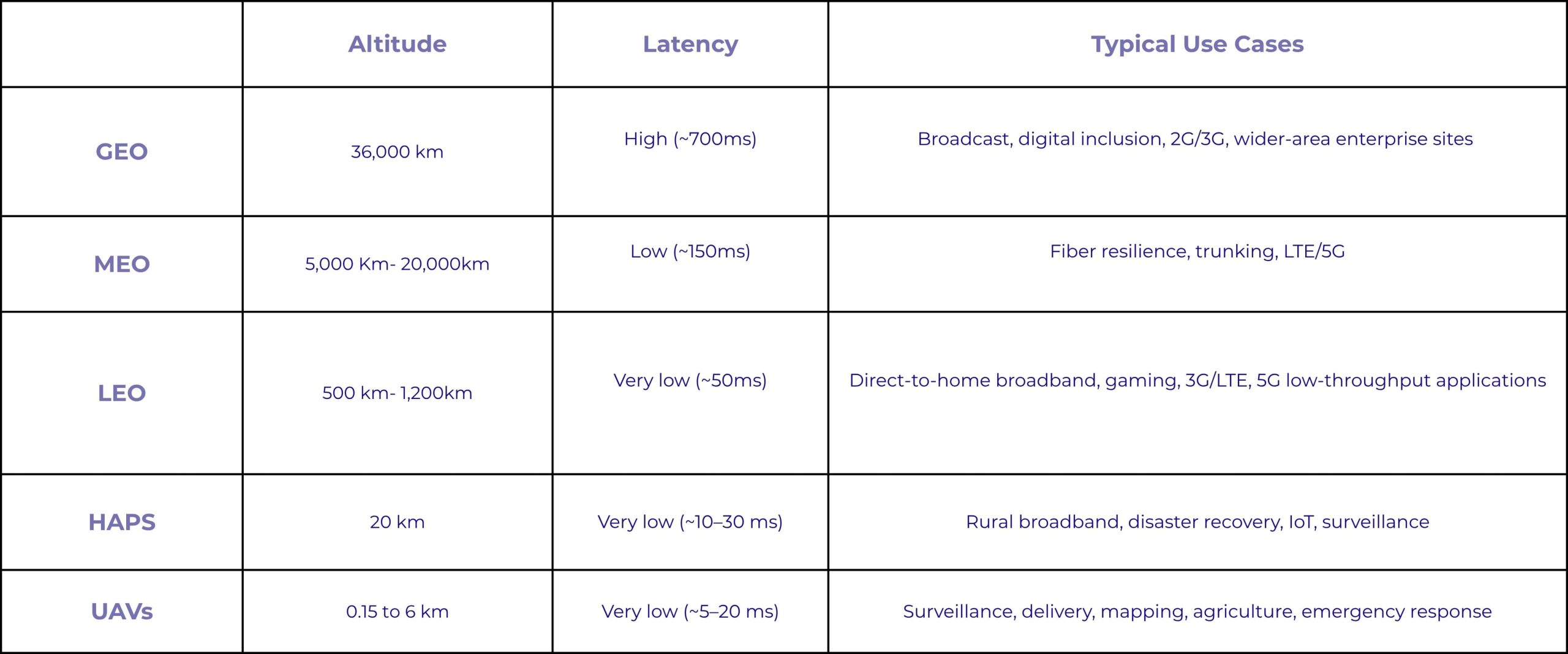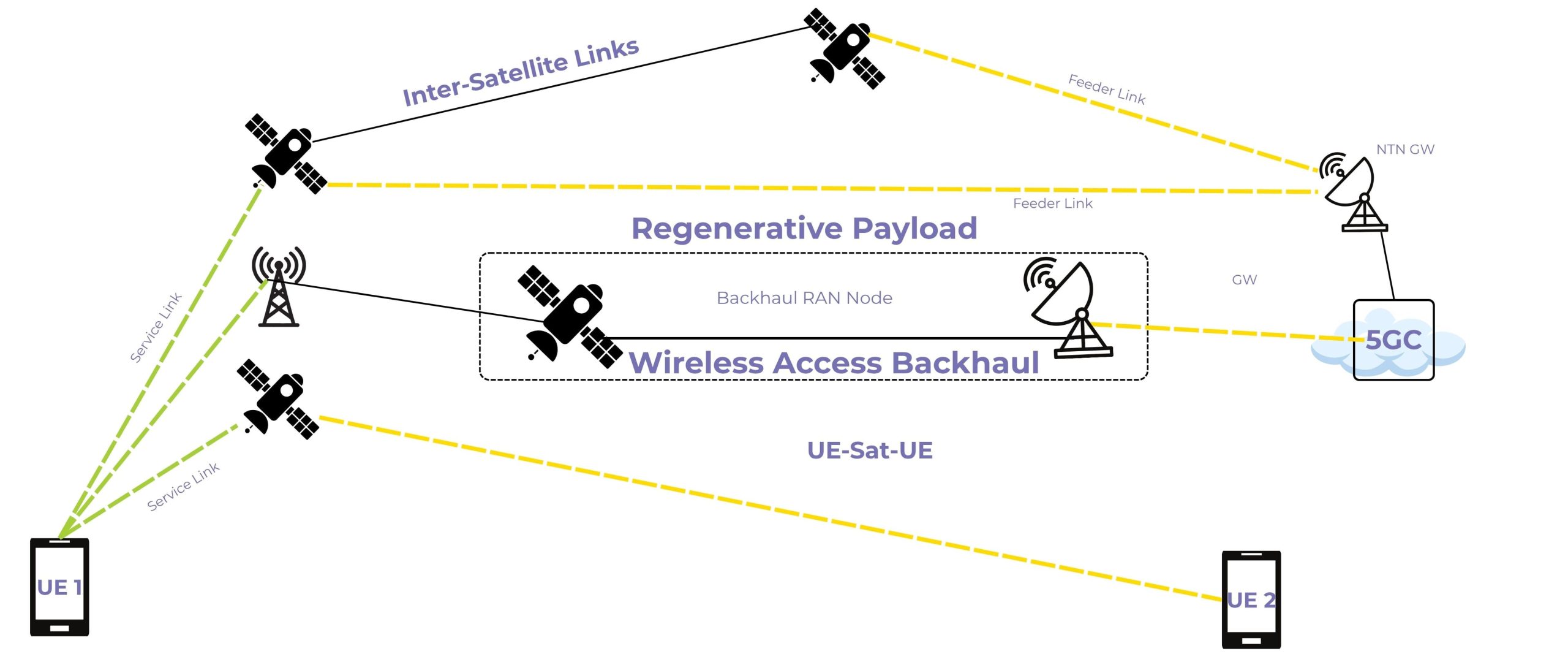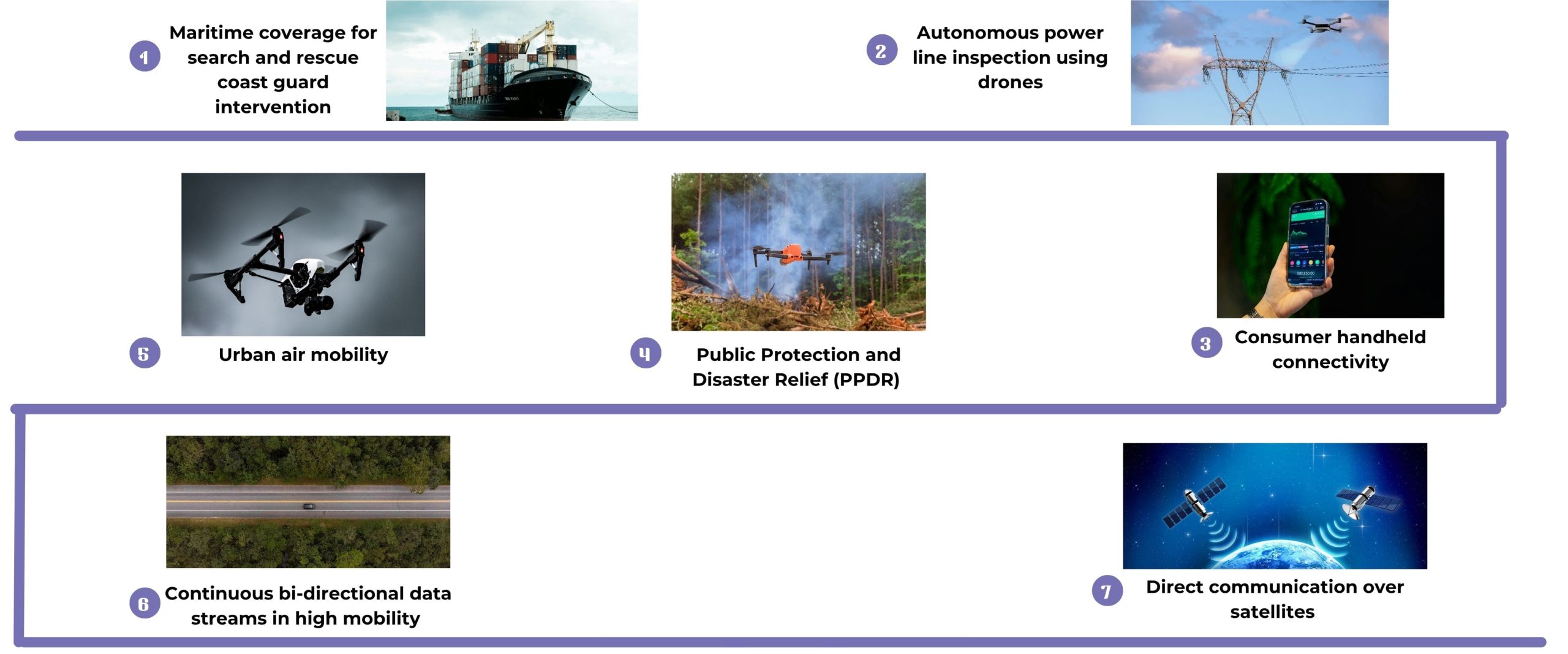- Blog
NTNs and SatCom in 5G/6G: A New Era of Ubiquitous Connectivity
As the world embraces the next wave of wireless innovation with 5G and looks ahead to 6G, one challenge remains unresolved: delivering consistent, high-speed connectivity in remote or hard-to-reach regions. Traditional terrestrial infrastructure—like fiber-optic cables and cell towers—faces both technical and economic limitations in sparsely populated or geographically challenging areas.
In an era where connectivity is crucial, Non-Terrestrial Networks (NTNs) are emerging as a transformative solution to bridge the digital divide. By integrating satellite communications (SatCom) and high-altitude platform stations (HAPS), NTNs extend the reach of traditional terrestrial networks to even the most remote and inaccessible regions. This technology enables seamless global coverage, unlocking new possibilities for mobile communication across rural, maritime, aerial, and even space environments. From drones and flying cars to ships and space stations, NTNs are paving the way for ubiquitous connectivity, ensuring that no location is left behind in the digital revolution.
Understanding NTNs and SatCom
Defined by 3GPP standards, Non-Terrestrial Networks (NTNs) encompass communication systems that operate via spaceborne and airborne platforms. These include satellites positioned in Low Earth Orbit (LEO), Medium Earth Orbit (MEO), and Geostationary Orbit (GEO); High-Altitude Platform Stations (HAPS) such as balloons and solar-powered aircraft; and Unmanned Aerial Vehicles (UAVs) operating at lower altitudes.
The table below summarizes the key characteristics and applications of these different modes.

Why NTN Matters for 5G/6G
The future of 5G—and even more so 6G—demands far more than urban coverage. Mission-critical applications such as autonomous logistics, disaster response, remote healthcare, and precision agriculture require connectivity where terrestrial networks fall short.
Use cases of NTN include:

Practical Insights
Recent trials have pushed the boundaries of satellite and UAV communications. An ESA(European Space Agency) – led test using a GEO satellite to backhaul a 5G gNodeB saw a 12% boost in return link and a 20% gain in forward link throughput, with seamless mobility per 3GPP Release 15 [1]. According to another study published on the Cornell University-hosted arXiv platform, Hybrid SatCom–UAV networks using FSO/RF links nearly doubled throughput and energy efficiency, even achieving 62× peak throughput in some cases [2]. A separate case highlights how integrating LEO-terrestrial networks also slashed UAV downlink outages from 70% to near-zero, while improving uplink reliability for ground users by 12% [3] .

As we look ahead to the evolution of 6G networks, Non-Terrestrial Networks (NTNs)—particularly satellite-based systems—are poised to play a transformative role in delivering seamless, global connectivity. Their inherent advantages, such as wide-area coverage and regulatory alignment, make satellites a cornerstone of future network architectures. However, integrating NTNs with terrestrial infrastructure introduces a host of complex challenges, including latency, Doppler effects, dynamic handovers, and resource management intricacies. To navigate these hurdles, Artificial Intelligence (AI) emerges as a powerful enabler, capable of learning and adapting to the multifaceted nature of satellite communications. By intelligently managing network slicing, routing, task offloading, and spectrum sharing, AI can unlock the full potential of NTNs in 6G. Current research is actively exploring AI-driven, software-defined solutions to enhance satellite-based NTNs, paving the way for smarter, more resilient networks. As we move forward, embracing AI will be key to realizing the vision of a truly ubiquitous and scalable 6G ecosystem.
Conclusion
As digital demands intensify and geographical boundaries fade, NTNs—especially in conjunction with SatCom—will be critical to delivering inclusive and resilient next-generation connectivity. At Tejas Networks, we are actively contributing to this evolution, building innovative solutions that bring the promise of 5G and 6G to every corner of the globe.
References
In an era where connectivity is crucial, Non-Terrestrial Networks (NTNs) are emerging as a transformative solution to bridge the digital divide. By integrating satellite communications (SatCom) and high-altitude platform stations (HAPS), NTNs extend the reach of traditional terrestrial networks to even the most remote and inaccessible regions. This technology enables seamless global coverage, unlocking new possibilities for mobile communication across rural, maritime, aerial, and even space environments. From drones and flying cars to ships and space stations, NTNs are paving the way for ubiquitous connectivity, ensuring that no location is left behind in the digital revolution.
Understanding NTNs and SatCom
Defined by 3GPP standards, Non-Terrestrial Networks (NTNs) encompass communication systems that operate via spaceborne and airborne platforms. These include satellites positioned in Low Earth Orbit (LEO), Medium Earth Orbit (MEO), and Geostationary Orbit (GEO); High-Altitude Platform Stations (HAPS) such as balloons and solar-powered aircraft; and Unmanned Aerial Vehicles (UAVs) operating at lower altitudes.
The table below summarizes the key characteristics and applications of these different modes.

Table 1: Different modes of NTN
SatCom, a vital subset of NTNs, establishes high-speed communication links via satellite. It is indispensable for delivering services across remote land, sea, and airborne environments, supporting both civilian and defense applications.Why NTN Matters for 5G/6G
The future of 5G—and even more so 6G—demands far more than urban coverage. Mission-critical applications such as autonomous logistics, disaster response, remote healthcare, and precision agriculture require connectivity where terrestrial networks fall short.
Use cases of NTN include:
- Extending broadband coverage to rural and underserved regions
- Providing reliable backup during natural disasters or network outages
- Enabling real-time connectivity for aviation, maritime, and defense sectors
- Supporting massive IoT deployments in areas lacking fiber or towers
- Delivering ultra-reliable, low-latency communications (URLLC) through hybrid networks

Figure 1: NTN architecture as per 3GPP Release 19
As per 3GPP Release 19 specifications, we can see certain key aspects of NTN. The satellite can be used as a platform to regenerate the payload received from NTN capable UE and the regenerated payload can be relayed to a ground station. In another possibility, one UE can connect to another UE via the satellite – this is shown in the UE-Sat-UE segment. NTN can also act as a part of the wireless backhaul infrastructure. Moreover, the Inter Satellite Link (ISL) is another important area of research and evolution.Practical Insights
Recent trials have pushed the boundaries of satellite and UAV communications. An ESA(European Space Agency) – led test using a GEO satellite to backhaul a 5G gNodeB saw a 12% boost in return link and a 20% gain in forward link throughput, with seamless mobility per 3GPP Release 15 [1]. According to another study published on the Cornell University-hosted arXiv platform, Hybrid SatCom–UAV networks using FSO/RF links nearly doubled throughput and energy efficiency, even achieving 62× peak throughput in some cases [2]. A separate case highlights how integrating LEO-terrestrial networks also slashed UAV downlink outages from 70% to near-zero, while improving uplink reliability for ground users by 12% [3] .

Figure 2: Suggested Use Cases of NTN
Looking Ahead: NTNs in the 6G EraAs we look ahead to the evolution of 6G networks, Non-Terrestrial Networks (NTNs)—particularly satellite-based systems—are poised to play a transformative role in delivering seamless, global connectivity. Their inherent advantages, such as wide-area coverage and regulatory alignment, make satellites a cornerstone of future network architectures. However, integrating NTNs with terrestrial infrastructure introduces a host of complex challenges, including latency, Doppler effects, dynamic handovers, and resource management intricacies. To navigate these hurdles, Artificial Intelligence (AI) emerges as a powerful enabler, capable of learning and adapting to the multifaceted nature of satellite communications. By intelligently managing network slicing, routing, task offloading, and spectrum sharing, AI can unlock the full potential of NTNs in 6G. Current research is actively exploring AI-driven, software-defined solutions to enhance satellite-based NTNs, paving the way for smarter, more resilient networks. As we move forward, embracing AI will be key to realizing the vision of a truly ubiquitous and scalable 6G ecosystem.
Conclusion
As digital demands intensify and geographical boundaries fade, NTNs—especially in conjunction with SatCom—will be critical to delivering inclusive and resilient next-generation connectivity. At Tejas Networks, we are actively contributing to this evolution, building innovative solutions that bring the promise of 5G and 6G to every corner of the globe.
References
- https://www”https://ieeexplore.ieee.org/9347998
- https://arxiv.org/abs/2010208.02683
- https://www.ntt-review.jp/archive/ntttechnical.php?contents=ntr202111fa3.html#:~:text=In%20the%205th%2Dgeneration%20mobile,altitude%20of%20about%203%20km
- https://ef=”https://www.ntt-review.jp/archive/ntttehp?contents=ntr202111fa3.html
- https://6g-ntn.eu/presentation-talks/
- https://ieeexplore.ieee.org/abstract/document/9861699
- https://ieeexplore.ieee.org/abstract/document/9658559


